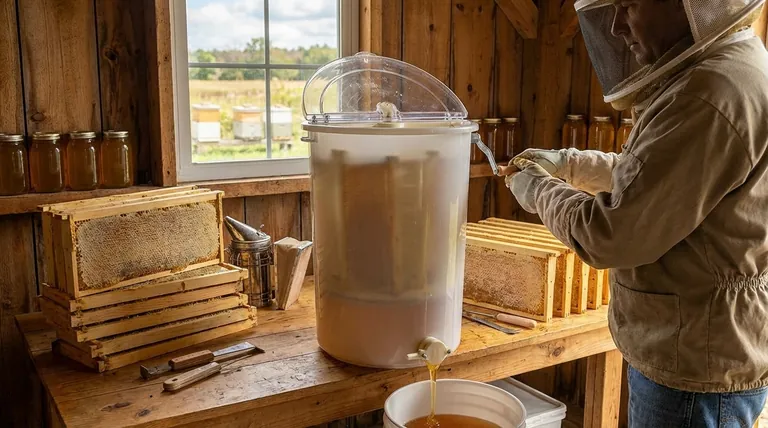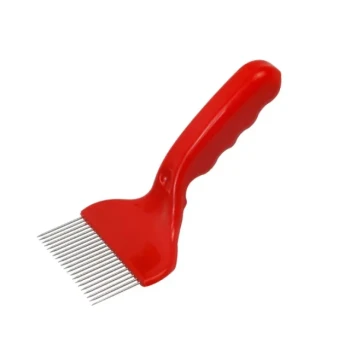In essence, manual honey extractors are the tool of choice for hobbyist beekeepers, beginners, or those operating on a small scale, typically with ten or fewer hives. Their decision is driven by a combination of lower cost, operational simplicity, and independence from a power source, which aligns perfectly with the needs of a smaller apiary.
While the number of hives is a useful guideline, the choice to use a manual extractor is fundamentally a strategic decision that prioritizes low cost and control over the speed and volume required for large-scale operations.

The Profile of a Manual Extractor User
The decision to use a manual extractor is less about a lack of options and more about selecting the right tool for a specific scale and context. Three primary user groups consistently find it to be the ideal choice.
The Hobbyist with a Few Hives
The most common user is the hobbyist beekeeper managing a small number of hives, usually between one and ten.
At this scale, the volume of honey to be processed does not justify the significant expense of an electric extractor. The manual process is manageable and often seen as a rewarding part of the beekeeping experience.
Beekeepers in Off-Grid Locations
Manual extractors require no electricity, making them indispensable for beekeepers in remote or off-grid locations.
Their mechanical simplicity ensures they can be used anywhere, from a remote cabin to a backyard with no convenient outdoor power outlets. This operational freedom is a significant advantage.
The Beginner Seeking Simplicity
New beekeepers are often drawn to manual extractors for their simplicity and low barrier to entry.
With fewer moving parts and no complex settings, a manual extractor is easy to understand and maintain. It allows the beginner to focus on the fundamental process of extraction without a steep learning curve.
Core Advantages of Manual Extraction
The appeal of manual extractors extends beyond just their target user. The benefits they offer are distinct and compelling for anyone operating within their intended scale.
Affordability and Lower Upfront Cost
The most significant advantage is the dramatically lower price point compared to electric models. This makes them highly accessible for individuals starting a new hobby without a large initial budget.
Simplicity and Control Over Speed
Manual extractors operate via a simple hand crank that spins the frames. This direct mechanical action gives the user precise control over the rotational speed.
This control is crucial for protecting delicate new comb from being damaged by the high, fixed speeds of some electric models. You can start slowly and increase speed as the frames lighten.
Operational Independence
Without the need for cords, motors, or a power source, these extractors offer complete location independence. They are also quieter and require less maintenance, as there is no motor to service or repair.
Understanding the Trade-offs
The choice to use a manual extractor comes with clear limitations. Understanding these trade-offs is crucial for making an informed decision and avoiding frustration as your apiary grows.
The Demands of Physical Labor
The primary drawback is that manual extraction is labor-intensive. Cranking the handle to spin heavy, honey-filled frames requires significant physical effort, especially when processing multiple hives.
Time Commitment and Inefficiency at Scale
The process is inherently slower than electric extraction. What might take minutes with an electric model can take much longer manually. This time commitment becomes a major inefficiency for anyone managing more than a handful of hives.
The Practical Limit on Hive Count
While the "ten hive" rule is a guideline, it exists for a reason. As an apiary grows beyond this point, the time and labor required for manual extraction often become unsustainable, pushing beekeepers to upgrade to an electric model for efficiency.
Making the Right Choice for Your Apiary
Ultimately, the best extractor is the one that aligns with your specific goals, budget, and the scale of your operation.
- If your primary focus is low cost and simplicity with 1-5 hives: A manual extractor is the most logical and economical choice.
- If your primary focus is efficiency for 10+ hives: An electric extractor will save you significant time and physical effort, justifying the higher cost.
- If your primary focus is operating in a location without electricity: A manual extractor is your only practical and reliable option.
Choosing the right tool is about correctly assessing your current needs and future ambitions as a beekeeper.
Summary Table:
| User Profile | Typical Hive Count | Primary Reason for Choosing Manual |
|---|---|---|
| Hobbyist Beekeeper | 1 - 10 | Low cost, manageable volume, rewarding process |
| Beginner Beekeeper | 1 - 5 | Simplicity, ease of use, low barrier to entry |
| Off-Grid Beekeeper | Any | Operational independence, no electricity required |
Ready to equip your apiary with the right tools?
Whether you're a hobbyist starting out or a distributor supplying the beekeeping community, HONESTBEE is your trusted wholesale partner. We supply durable, high-quality beekeeping supplies and equipment—from manual extractors to full apiary setups—designed for commercial apiaries and equipment distributors.
Let's help you build a more efficient and productive operation. Contact our team today to discuss your needs and explore our wholesale catalog!
Visual Guide

Related Products
- Plastic Hand Crank 2 Frame Honey Extractor Low Price
- 6 Frame Manual Stainless Steel Honey Extractor Beekeeping Equipment
- HONESTBEE 3-Frame Manual Acrylic Honey Extractor
- 2 Frame Stainless Steel Manual Honey Spinner Extractor for Beekeeping
- HONESTBEE 8 Frame Electric and Manual Three Use Honey Extractor
People Also Ask
- What makes polyurethane foam environmentally friendly? The Surprising Benefits of a Durable, Inert Material
- Can honey be harvested from frames with brood? The Critical Rule for Healthy Bees & Pure Honey
- Can manual honey extractors effectively remove honey from cells? A Guide for Small-Scale Beekeepers
- Why are manual extractors popular among beginner beekeepers? A Guide to Starting Simple & Saving Money
- What are the advantages of manual honey extractors? Ideal for Hobbyist & Small-Scale Beekeepers



















